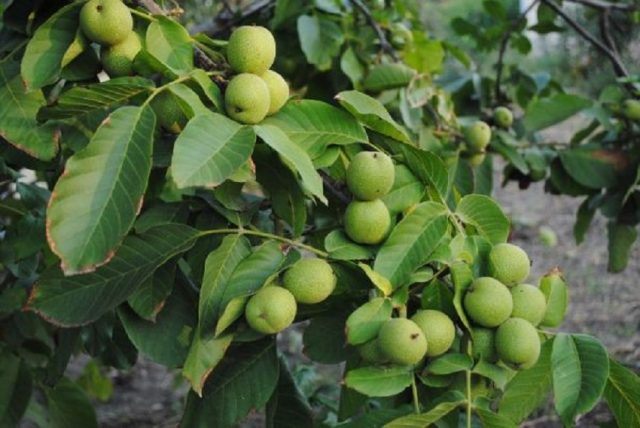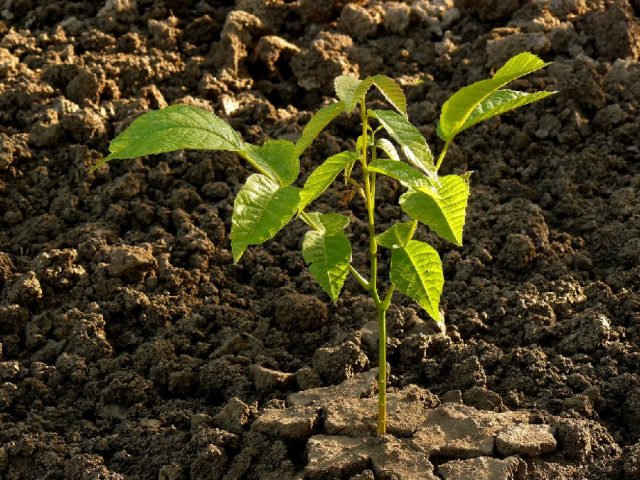Content
Walnut Ideal fell in love with gardeners from the first acquaintance. First of all, the fact that it can be grown in those regions where other varieties are unprofitable. The ideal is fast-growing, frost-resistant, small in adulthood. Gardeners are happy to plant a new species for the sake of yielding delicious hearths.
Walnut Description Ideal
The ideal was bred by Uzbek breeders in 1947 in order to get an early, hardy, fruitful variety of walnut.
The new species has helped to significantly expand the cultivation areas of the crop. The description of the nut should start with the appearance of the tree and the main characteristics:
- The adult tree is much less tall than other varieties. The ideal size reaches 4-5 m, which is very little for a nut.
- The bark on the stem is grayish-brown in color, it acquires brown color on skeletal branches and fruiting shoots. Young growth is easy to distinguish by the bark of a green tint with a bluish bloom.
- Leaves are dense, large, dissected into parts of an oval-pointed shape.
- The flowers of the nut are dioecious. They are small, white with a greenish tinge, wind-pollinated, in one cluster from 8 to 15 flowers. The peculiarity of the variety is the second wave of flowering, which begins 1-2 weeks after the first. If the year is successful in terms of climatic conditions, then the gardeners reap the second harvest. The second wave lasts until autumn. In spring, there is a danger of damage to flower buds by recurrent frosts. Therefore, if the first harvest suffers, then the second wave gives, if not a full-fledged, but worthy harvest. Ripening lasts from early September to late October.
- The fruits are oval in shape, the average weight of one nut is 8-11 g. The shell is thin, light beige. No effort is required for splitting, the kernels are large with a high content of nutrients, mainly fats and proteins.
- The appearance of the first ovaries begins 2-3 years after planting the seedling. A stable yield has been observed since the 6th year. One large Ideal tree produces 100-120 kg of large fruits. The nut belongs to varieties of early fruiting.
- The variety is resistant to chlorosis.
Walnut Photo Ideal:
Pros and cons of the variety
Advantages and disadvantages are easy to collect into groups, focusing on the description of the Ideal walnut variety and gardeners' reviews. Among the pluses are noted:
- Early maturity... The variety begins to bear fruit very early.
- Compactness of wood... Ideal compares favorably with the size of other varieties of walnut. Therefore, other crops can be planted next to it at a closer distance than from an ordinary nut.
- Frost resistance... The variety can withstand temperatures down to -30-35 ° C without damage.
- Undemanding to the composition of the soil... When planting an Ideal walnut seedling, no special soil mixture is required. The plant grows normally on soil with high acidity.
- Double fruiting... The characteristic allows you to harvest even in the case of spring freezing of flower buds.
- High annual yield.
The cons of the walnut Ideal are:
- The fragility of the variety... This is due to the early maturity of the Ideal walnut. Such species live on average 40-50 years, a common walnut grows for 100 years or more.
- Instability before return frost.
Optimal growing conditions
Ideal walnut prefers well-lit areas with normalized humidity. The strong root system penetrates deeply into the ground, therefore, areas with a close occurrence of groundwater should be avoided. It is also not recommended to plant a tree next to buildings so that the grown nut does not damage them. The variety is distinguished by a strong spreading of branches. Special care from a gardener is needed in the first year after planting a seedling. At this time, the Ideal grows reluctantly. If the tree overwinters successfully, then the next year it already develops much more actively, and in autumn it reaches a height of up to 1.3 m.
Planting and caring for walnuts Ideal
The planting process does not differ from the stages traditional for walnuts. The gardener needs to be careful to withstand all the nuances. The culture is characterized by capriciousness in the first years of life, then it gains strength and grows without any problems. Maintenance requirements include adherence to the watering schedule and crown formation. Pruning is necessary for the ovaries to have enough light. Planting is scheduled for spring or autumn. When seedlings are planted for the winter, during the summer they reach a size of 15 cm. In the second year, the second stage of development occurs. The best time for autumn planting is a month before the onset of frost.
Selection and preparation of the landing site
For a walnut tree, an area is allocated that is well lit by the sun and protected from strong winds. Especially the northern direction. Although the plant is compact, it cannot stand tightness. Therefore, if you plan to plant several Ideal walnut seedlings, then 4.5-5 m are left between them. Although the originators of the variety indicate that the tree grows on acidified soil, it is still recommended to choose a site with soddy-carbonate loam.
Seedling preparation
If there is a choice between a grafted and a self-rooted seedling, then gardeners prefer the first option. This is because specimens obtained from seeds do not always retain all parental characteristics. The culture is cross-pollinated, and the seeds do not always convey all the advantages of the Ideal walnut.
When choosing a seedling, pay attention to the condition of the bark and roots. You should not purchase copies with alarming factors:
- the presence of any damage;
- even small foci of decay;
- weak or sluggish root system.
The ideal does not like unnecessary transplants, and if the plant is unhealthy, it may die. It is recommended to buy seedlings with a closed root system. When planting such a nut, the absorption and root growth zones will remain intact.
Landing rules
The variety must be immediately planted in a permanent place, it does not tolerate transplanting.
If the seedling is grown from seed, then it is germinated in advance in wet sand. A step-by-step description of planting an Ideal walnut looks like this:
- Prepare a planting pit with dimensions of 60x60 cm. You do not need to deal with the pit first, you can dig it on the day of planting.
- Mix soil with peat and humus in a 1: 1: 1 ratio. Add 0.5 kg of dolomite flour and 0.6 kg of superphosphate. Then 0.5 kg of wood ash. Fill the bottom of the pit with soil mixture.
- If a nut seedling with an open root system, then the roots are dipped in a clay mash. It is prepared from 1 part of manure (decayed) and 3 parts of clay, which are mixed and diluted with water to a state of sour cream. The root former Kornevin or Heteroauxin is added. The roots are left to dry for 25-30 minutes.
- A support is installed near the mound of earth.
- A nut seedling is located on top of an earthen mound. The lower roots are distributed along the sides of the slope, the upper ones are laid horizontally. The depth of the upper roots is 7-8 cm.Important! The root collar should be 3-5 cm above the soil surface.
- Fix the seedling to the support.
- Fill up the hole and mulch.
When planting a nut from a closed root system, you need to carefully transfer the plant into a hole with a lump of earth. Then cover with earth and water.
Watering and feeding
Watering is most needed by young nuts in spring and summer. During this period, the Ideal consumes a large amount of moisture. Also, trees are additionally watered in dry times. Each plant requires at least 20-30 liters of water per 1 sq. m area. The average frequency of watering is 2 times a month. When the height of the nut reaches 4 m, the watering intensity is reduced.
The Ideal is fed twice a year - in spring and autumn. Spring feeding should contain nitrogen fertilizers, autumn - potash and phosphorus. Adult plants from 20 to 50 years old require 7 kg of ammonium nitrate, 10 kg of superphosphate, 3 kg of potassium salt. When applying nitrogen fertilizers, you need to adhere to the rules:
- It is imperative to maintain the dosage. Excess leads to the multiplication of pathogenic microorganisms that cause diseases of the nut.
- Do not introduce nitrogen components at the beginning of fruiting of the variety (2-3 years), so as not to stimulate the growth of green mass, but to allow the formation of ovaries.
The nut responds well to root watering with a solution of chicken manure.
Trimming and shaping
It is not necessary to constantly prune and shape the walnut tree. It is important to remove dry, broken branches and thin out the crown a bit. This is necessary for uniform lighting of the branches. If you need to cut an unnecessary branch, this is done in two stages. The first time the branch is not cut completely. A knot 7-8 cm in size is set aside on the tree. It is removed the next year after drying. Ideal walnut bears fruit on annual shoots, so pruning is done in order to provide them with good lighting.
Preparing for winter
Cooking for the winter season begins in the summer. In the second half of August, watering is stopped, nitrogen fertilizers are very carefully dosed. This makes it possible for the wood to mature better before the onset of cold weather. In the fall, the near-stem circle is mulched with manure for a first-year seedling or humus for an older nut. Young trees are covered with spruce branches or wrapped in paper.
Reproduction
There are two types of propagation of Ideal walnut:
- Seeds... Intact healthy fruits are selected in the stage of cracking of the green shell. Then they are dried in a dry room. The seeds are germinated before planting. Stratification is desirable. Seeds are planted in early April. Large specimens are buried by 10 cm, small ones by 7 cm. Be sure to lay them on the edge.
- Grafted seedlings... It is preferable to graft with a cuttings, and not with a kidney, which can freeze out in winter.
Gardeners claim that the methods make it possible to obtain an accurate reproduction of the properties of the Ideal walnut and its varietal characteristics.
Productivity of walnut Ideal from 1 tree
The yield of the Ideal variety is characterized by annual stability. A mature tree produces 100 kg of quality fruit. With a good agricultural background, the yield increases to 120 kg per nut.
Harvesting and storage
Time is determined by the state of the green pericarp. Harvesting begins when the green shell begins to crack.
The collected nuts are kept in the basement for a week. Then the pericarp, which has not lagged behind, is cleaned. To make it easier to remove the green peel, stir the nuts in the sun.
Diseases and pests
Among the diseases to which the walnut Ideal can be exposed, it should be called:
- bacteriosis;
- bacterial burn;
- brown spot.
For control and prevention, copper-containing preparations are used, spraying with a Bordeaux mixture (1%) is carried out.
Of the pests, walnut moth, walnut moth, wart mite, sapwood can annoy. For the fight, agents permitted for use on nut varieties are used.
Conclusion
Ideal walnut is grown in different regions.This variety produces a good harvest in climates where others do not survive. The only condition for gardeners is to comply with the requirements of agricultural technology.
Walnut Reviews Ideal












